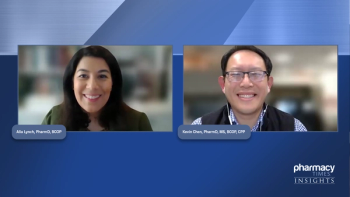
Effects of TKI Resistance and Intolerance
Experts review how the rates of tyrosine kinase inhibitor resistance affect treatment options for these populations and how to sequence treatment for these patients.
Episodes in this series

Brandon Dyson, PharmD, BCOP, BCPS: TKI [tyrosine kinase inhibitor] resistance or intolerance is a major driver of CML [chronic myeloid leukemia] therapy. I’ve alluded that 90% adherence is optimal to get the best response. It doesn’t matter how effective a given drug is, if a patient can’t or won’t take it, then it’s not going to have much of an effect. That’s the tolerance piece of that, in terms of how it’s going to affect which drug to use. That’s part of the upfront decision in terms of, if we’re worried about fluid retention, or edema, or something that you might see a higher rate of with imatinib, then maybe that’s not the best first-line option. If you’re worried about diarrhea, maybe bosutinib is not the best first-line option. So that drives your selection and how to sequence therapy.
Resistance is the other part. There’s a chart in the NCCN [National Comprehensive Cancer Network] guidelines that details which resistance mutations knock out which TKIs. That shows you once you start getting into resistance profiling of a patient, you can determine, this is not an option, this is not an option, and so on and so forth. And again, the T315I mutation knocks out every TKI except for ponatinib. It really steers where therapy goes in terms of subsequent lines.
Neal Dave, PharmD: To determine the rates of resistance to CML and Philadelphia [chromosome]-positive ALL [acute lymphoblastic leukemia], you have to identify what the cause of the resistance is. Is it a compliance issue? This is a disease state where there have been numerous reports that having 90% compliance is essential to have better response, better outcomes, fewer hospitalizations, and lower overall cost of care for the patient. It’s really important to identify what the cause of the resistance is. If it’s a compliance issue, and you have a patient who has to take a drug twice a day, it’s going to be more difficult for that patient to be compliant on that regimen vs a regimen that’s only once-a-day dosed.
But then you also have to look at the adverse effect management, and can that patient tolerate that dose? Or why is that patient not being compliant? A lot of this is basic and holds true for any drug or drug therapy you’re giving. The hard part of prescribing a drug is ensuring patients take the drug therapy. Now, if the incidence of resistance was really high, and you know there are a lot of mutations in this disease state, where a first-generation TKI, or maybe some of the second-generation TKIs won’t work, if those data were out there, then you could prescribe one of the TKIs that best fits that particular mutation or that particular type of CML disease. Based on where we are now, I think it makes sense to continue to monitor patients at 3-, 6-, and 12-month intervals to see where their response is and then either keep them on therapy or progress onto another TKI.
When patients have gone through multiple lines of therapy, they’ve gone through multiple TKIs, to determine how to manage that it depends on the reason for why they are not getting a response, again. Maybe it’s, has the mutational testing been done for that patient? And are we treating with the right TKI? I think those are questions that need to be addressed. If we haven’t tried, particularly for the T315I mutation, if we haven’t tried one of the TKIs that can work on that, then that’s what we need to do. Then we’re not giving the right therapy at the right time. That’s the first thing to look at.
Transript edited for clarity.
Newsletter
Stay informed on drug updates, treatment guidelines, and pharmacy practice trends—subscribe to Pharmacy Times for weekly clinical insights.













































































































































































































